Giáo trình Thương mại điện tử căn bản (Phần 2)
1. Xây dựng hệ thống thƣơng mại điện tử trong doanh nghiệp
Công nghệ thông tin là tập hợp các phương pháp khoa học, công nghệ và
công cụ kỹ thuật hiện đại để sản xuất và truyền đưa, thu thập, xử lý, lưu trữ và
trao đổi thông tin số. (Khoản 1 – Điều 4 – Luật Công nghệ thông tin năm 2006).
Hệ thống thông tin hiểu theo nghĩa rộng là tập hợp và kết hợp của các
phần cứng, phần mềm và các hệ mạng truyền thông được xây dựng và sử dụng
để thu thập, tạo và tái tạo, phân phối và chia sẻ thông tin nhằm phục vụ các mục
tiêu của tổ chức
Chức năng của hệ thống thông tin
- Nhập dữ liệu: thu thập và nhận dữ liệu để xử lý250
- Xử lý dữ liệu: chuyển đổi dữ liệu thành thông tin có nghĩa với người sử
dụng
- Xuất thông tin: phân phối thông tin đến những người hoặc hoạt động cần
sử dụng thông tin đó
- Lưu trữ thông tin
- Cung cấp thông tin phản hồi: nhằm hỗ trợ quá trình kiểm tra, đánh giá
lại và hoàn thiện hệ thống.
1.1. Lƣu trữ wesbite thƣơng mại điện tử
1.1. 1. Một số phƣơng pháp lƣu trữ website
Bản chất của website là tập hợp các trang web (webpages) dưới dạng các
trang web sẵn có (các trang tĩnh) hoặc các trang web được tạo ra từ các tài
nguyên và cơ sở dữ liệu (các trang động). Lưu trữ website là một trong các vấn
đề quan trọng nhất của thương mại điện tử, tương tự như tổng hợp các việc lưu
trữ công văn, giấy tờ, sổ sách kế toán, kho hàng, cửa hàng trong thương mại
truyền thống.s
Việc lưu trữ website thương mại điện tử bao gồm cả lưu trữ dữ liệu (thông
tin về doanh nghiệp, sản xuất, kinh doanh, khách hàng ), hệ thống phần mềm
xử lý các giao dịch điện tử (mua bán trực tuyến, quản lý hóa đơn, dịch vụ khách
hàng ) và những nội dung khác trên website (catalogue điện tử, báo cáo, tài
nguyên số ). Tùy theo quy mô của hệ thống thương mại điện tử mà số lượng,
cấu hình của hệ thống máy chủ cần sử dụng để lưu trữ các website thương mại
điện tử sẽ khác nhau.
Hiện nay, có một số phương pháp cơ bản để lưu trữ các website thương
mại điện tử như sau:
- Tự đầu tƣ mua các máy chủ về lắp đặt tại cơ sở của doanh nghiệp,
thuê chuyên gia thiết kế và xây dựng hệ thống mạng cũng như cài đặt các phần
mềm cần thiết để quản trị hệ thống máy chủ của doanh nghiệp.
+ Nhược điểm: Chi phí đầu tư xây dựng hệ thống máy chủ của riêng
doanh nghiệp rất lớn, về cơ sở hạ tầng, về máy móc, thiết bị, chi phí thuê thiết251
kế hệ thống và quản trị hệ thống sau này. Để giảm thiểu chi phí hạ tầng, doanh
nghiệp có thể vẫn đầu tư máy chủ nhưng thuê chỗ để đặt máy chủ tại các nhà
cung cấp dịch vụ này. Như vậy, tránh đầu tư xây dựng các phòng máy chủ vốn
có tiêu chuẩn kỹ thuật rất cao và tránh thuê đường truyền riêng để kết nối đến
các máy chủ của mình. Cách làm này vẫn đảm bảo được bí mật thông tin của
doanh nghiệp do các máy chủ được lưu giữ tại các phòng được bảo mật cao.
Hiện nay, tại Việt Nam, hệ thống máy chủ của các ngân hàng, trường đại học,
hải quan, thuế thường được tự xây dựng và vận hành bên trong tổ chức.
+ Ưu điểm: Mức độ an toàn của thông tin và chủ động trong vận hành hệ
thống cũng như nâng cấp, mở rộng sau này. Bên cạnh đó, khả năng tự xây dựng,
quản trị hệ thống máy chủ thương mại điện tử cũng là một năng lực cạnh tranh
quan trọng của các doanh nghiệp khi tham gia kinh doanh điện tử.
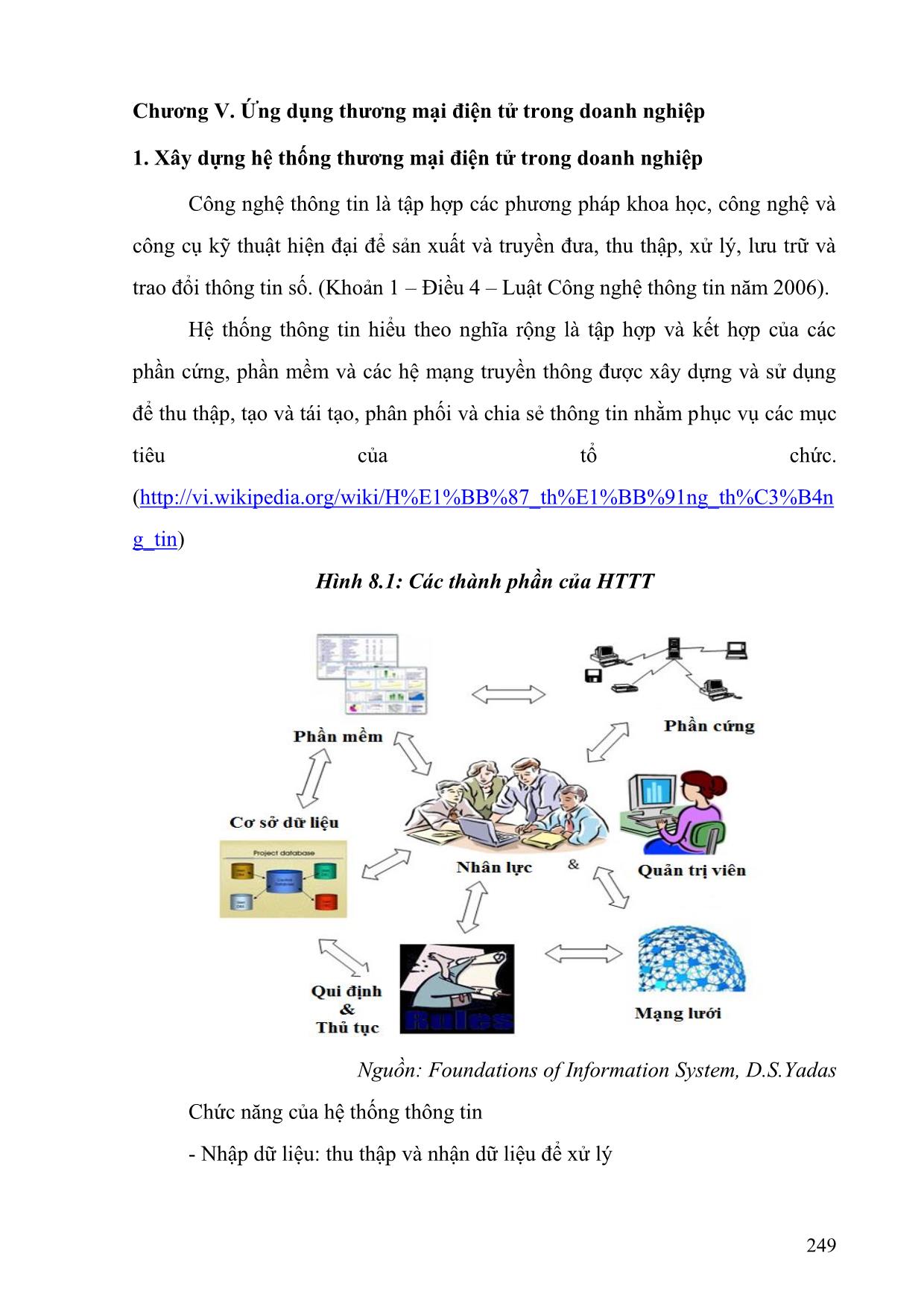
Trang 1
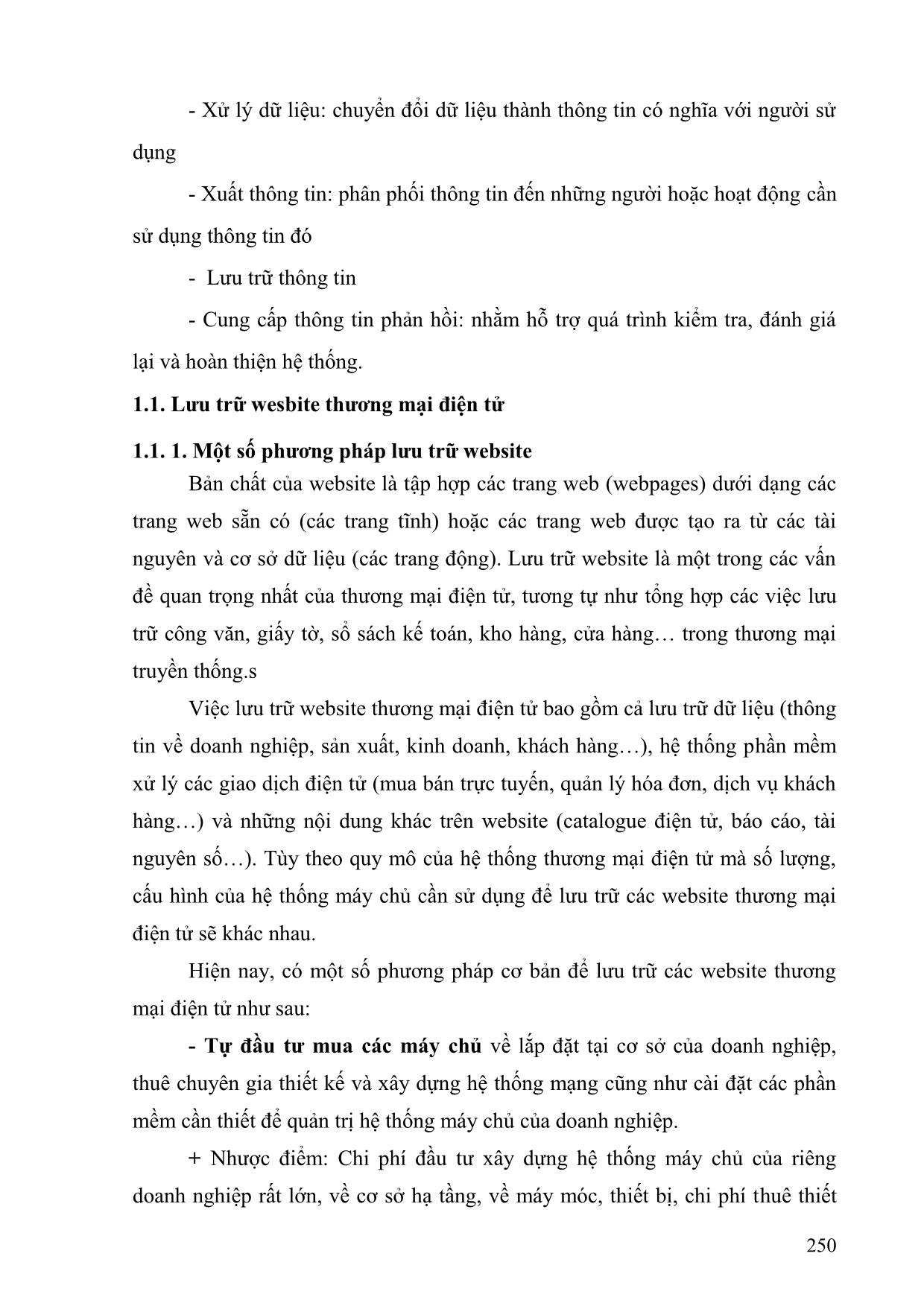
Trang 2
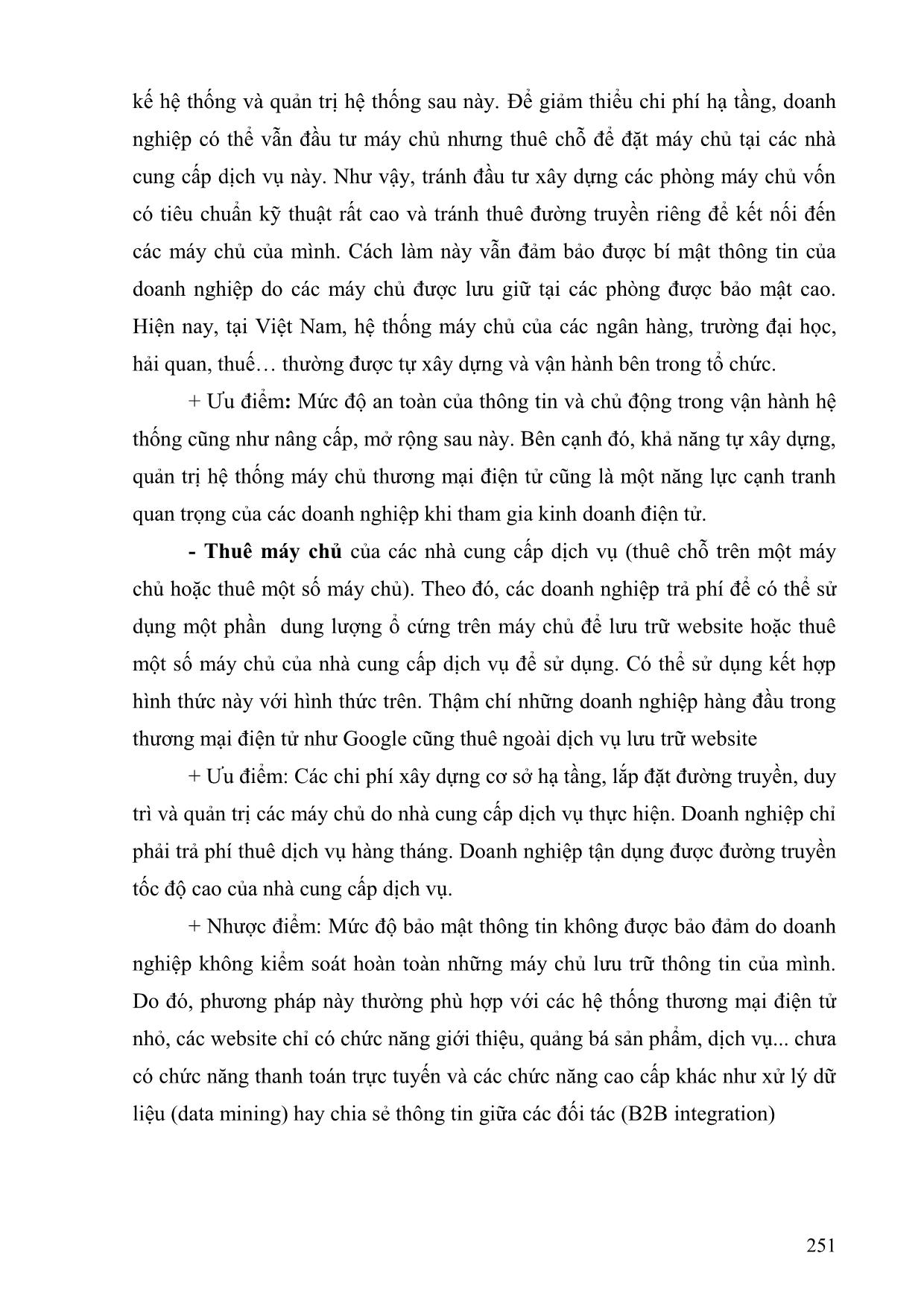
Trang 3
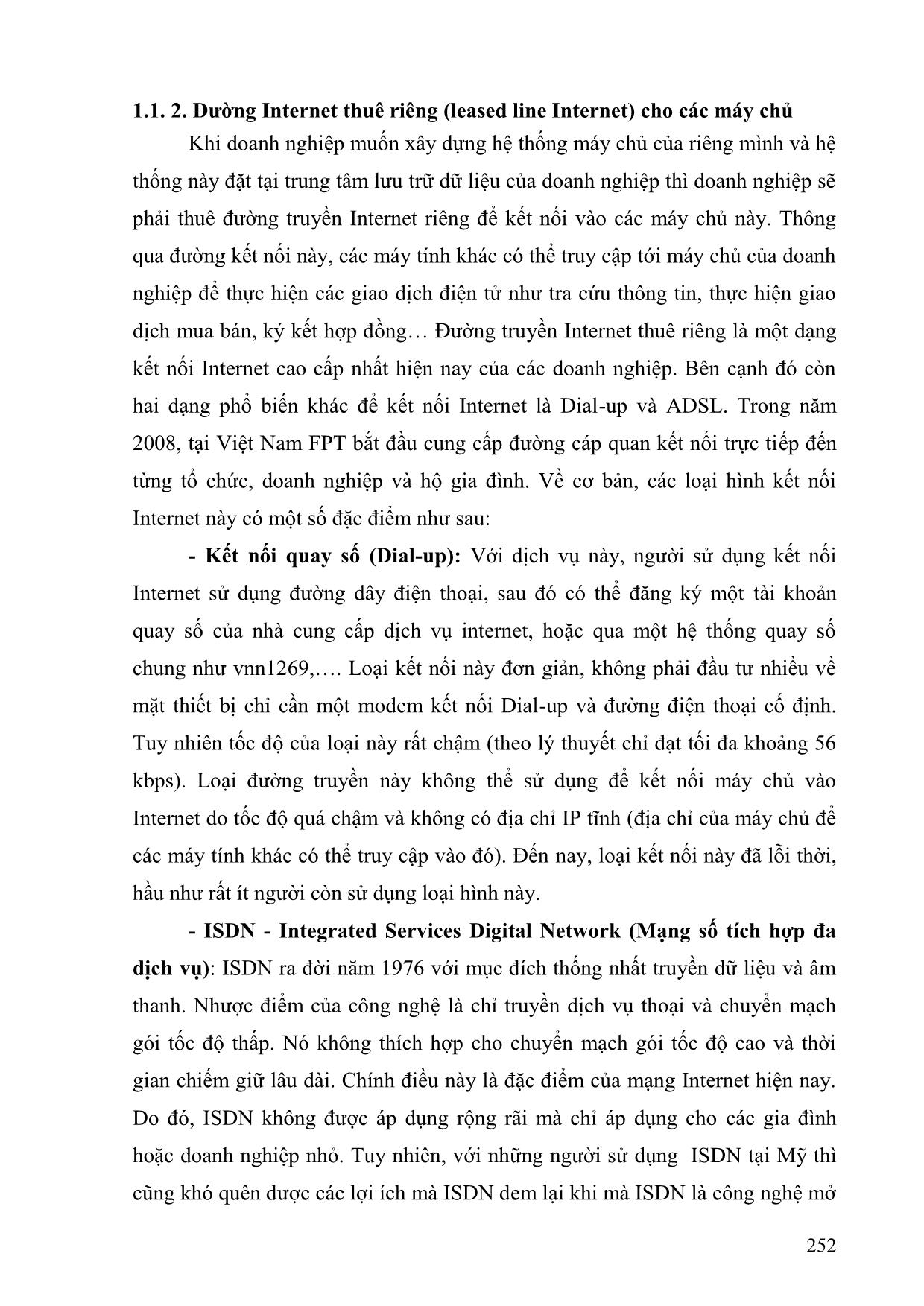
Trang 4
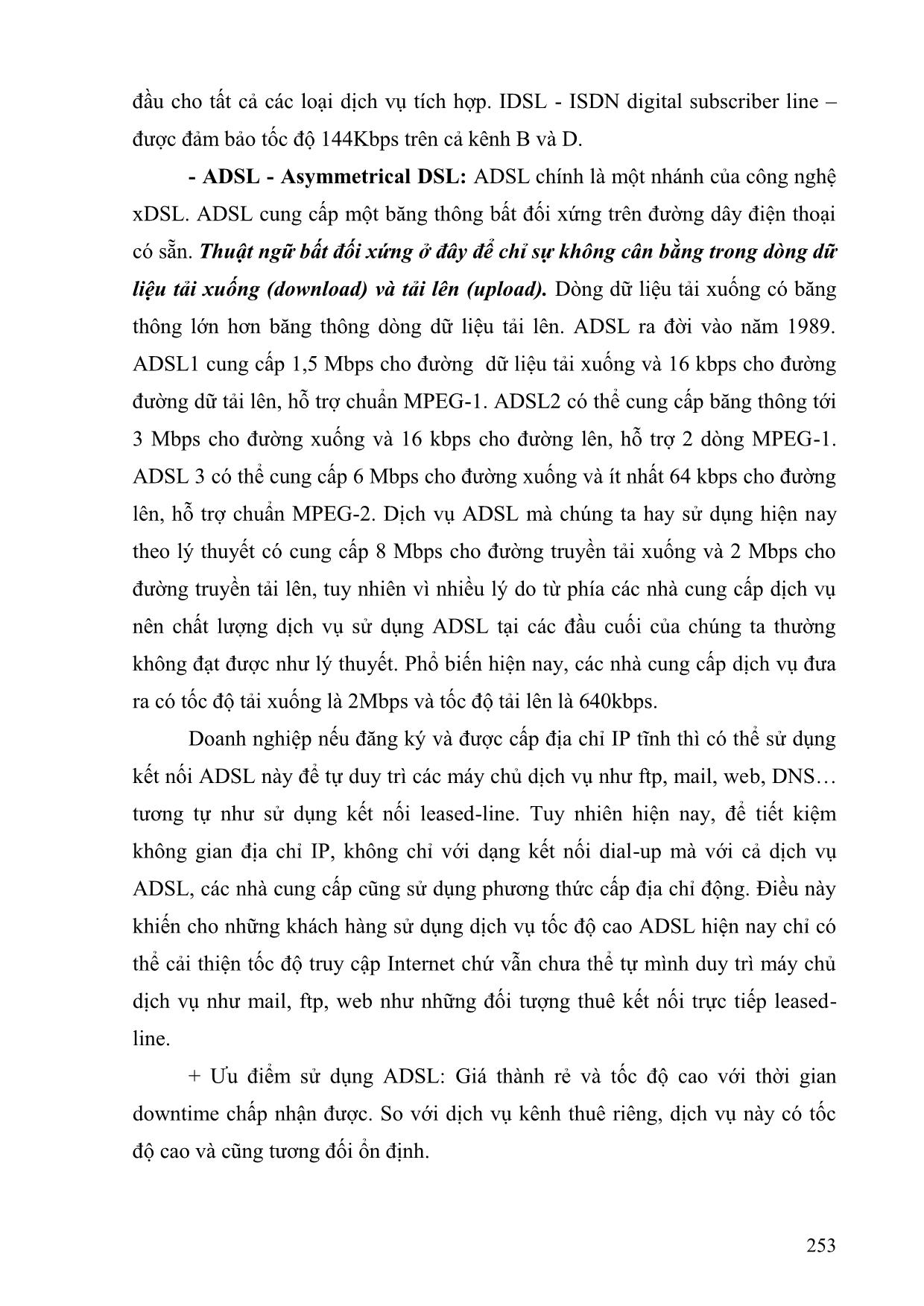
Trang 5
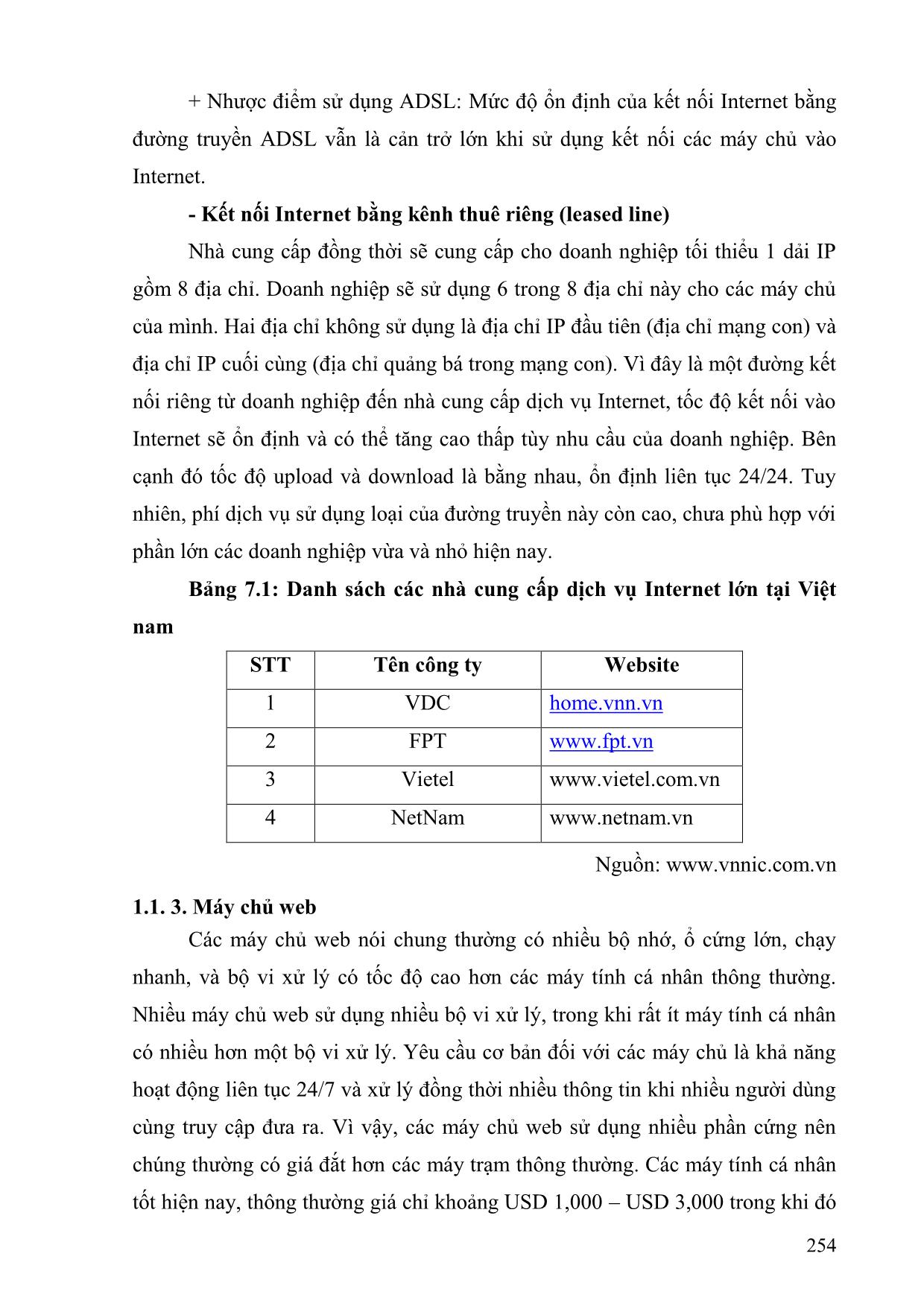
Trang 6
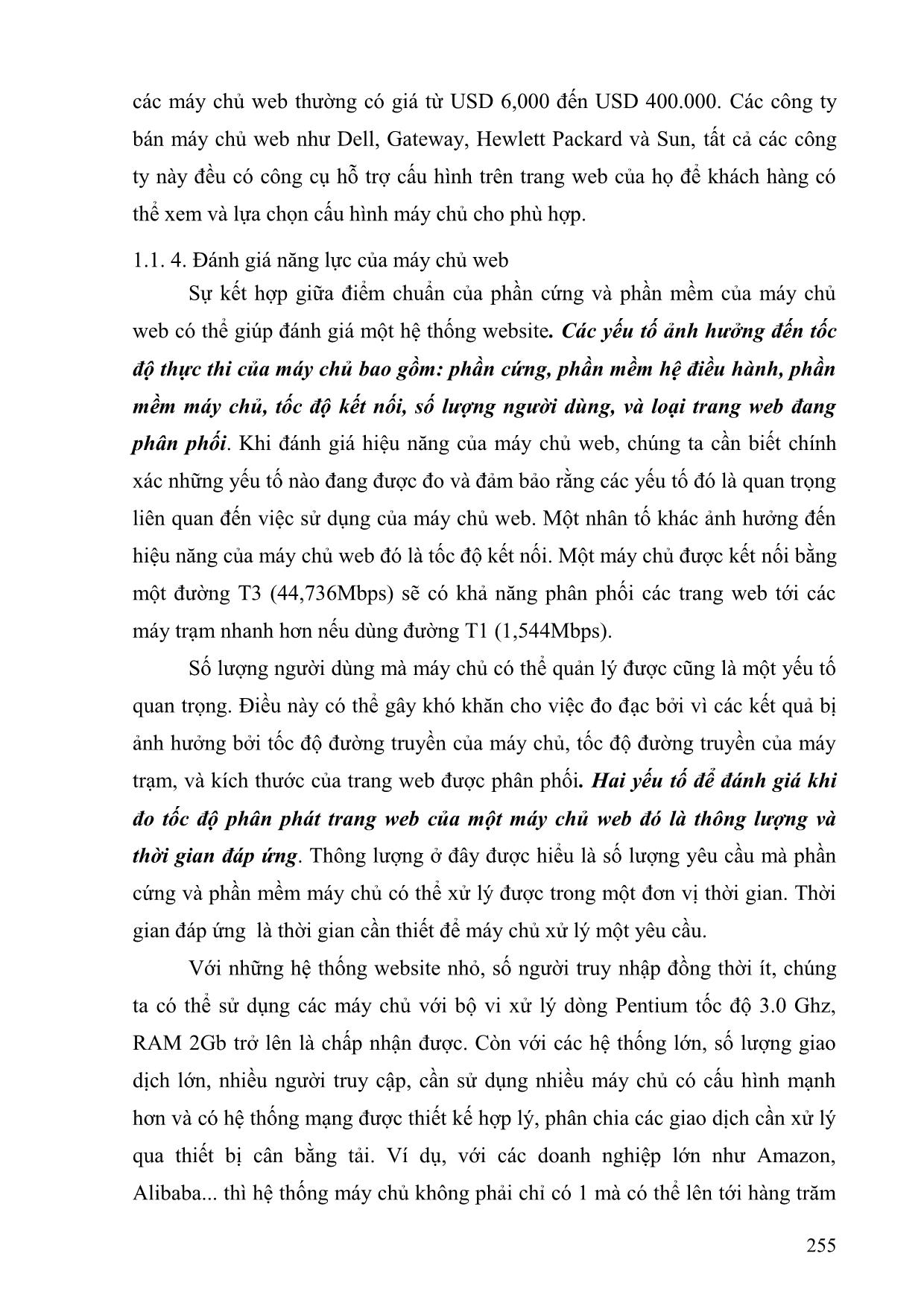
Trang 7
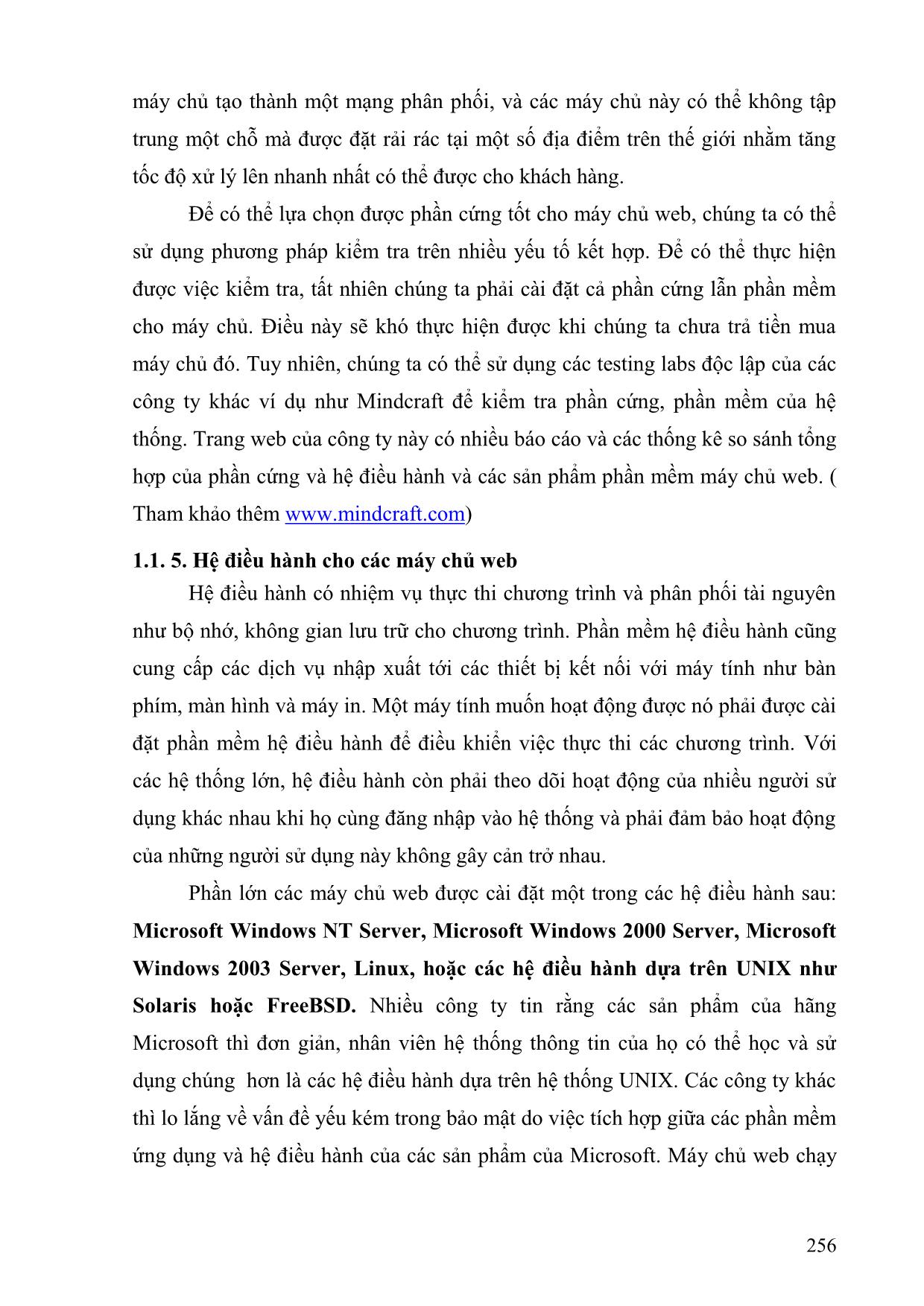
Trang 8
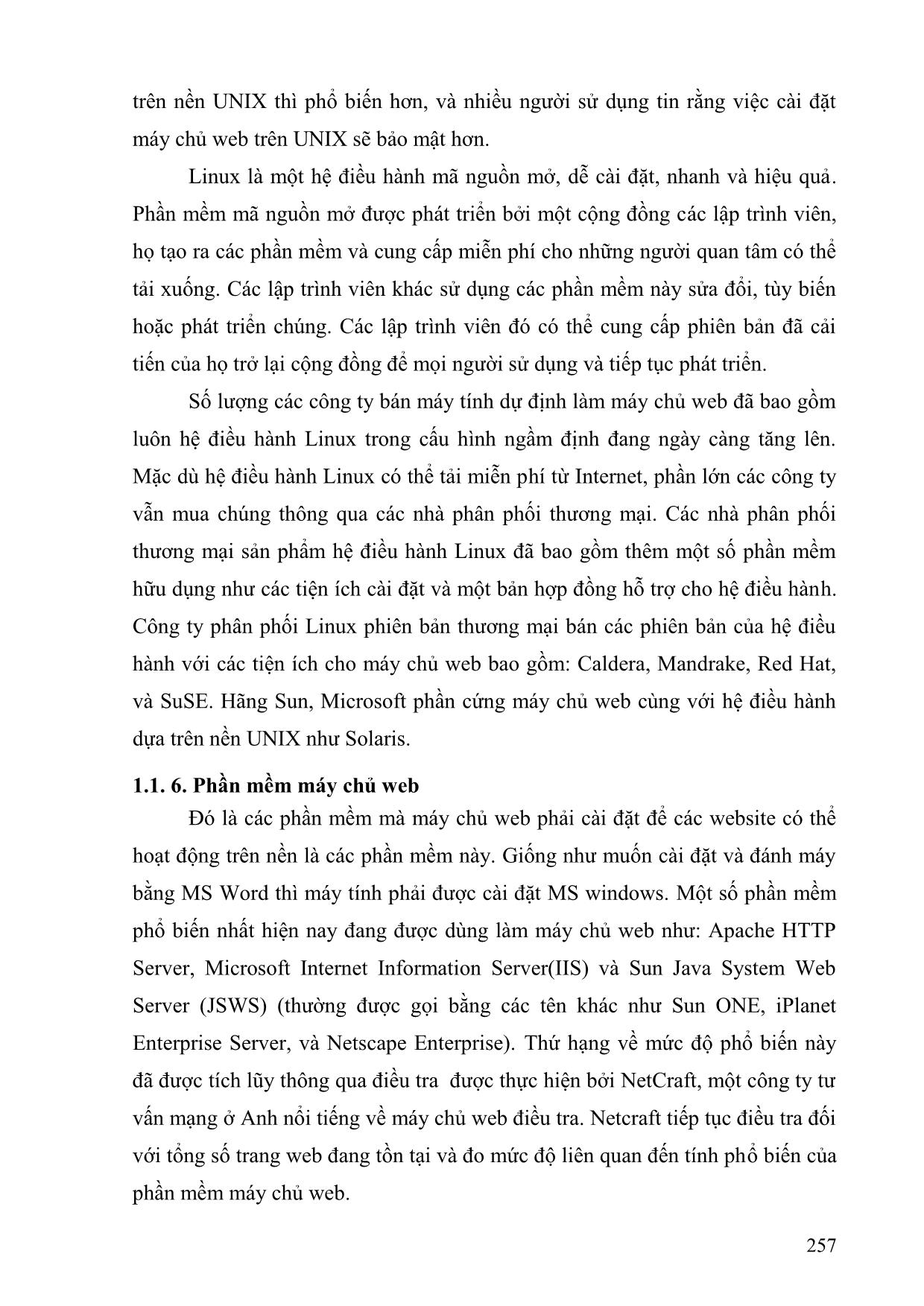
Trang 9
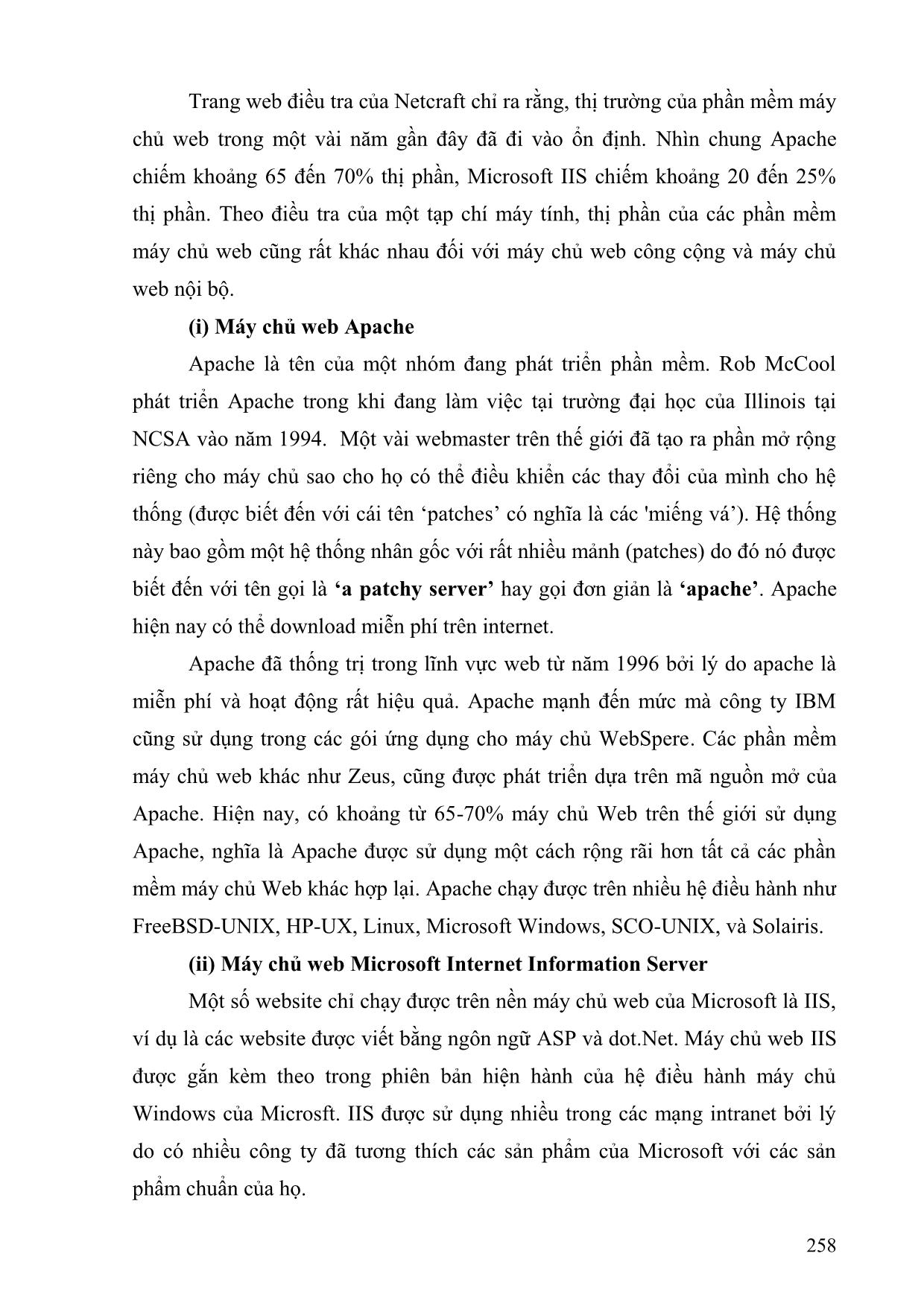
Trang 10
Tải về để xem bản đầy đủ
Tóm tắt nội dung tài liệu: Giáo trình Thương mại điện tử căn bản (Phần 2)
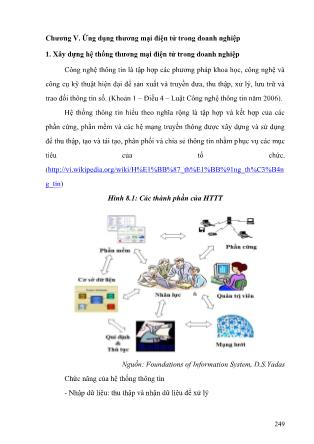
he time when it leaves an information system under the control of the originator or of the party who sent it on behalf of the originator or, if the electronic com- munication has not left an information system under the control of the originator or of the party who sent it on behalf of the originator, the time when the electronic communication is received. 2. The time of receipt of an electronic communication is the time when it becomes capable of being retrieved by the addressee at an electronic address designated by the addressee. The time of receipt of an electronic communication at another electronic address of the addressee is the time when it becomes Trường Đại học Ngoại thương 593 capable of being retrieved by the addressee at that address and the addressee becomes aware that the electronic communication has been sent to that address. An electronic communication is presumed to be capable of being retrieved by the addressee when it reaches the addressee‟s electronic address. 3. An electronic communication is deemed to be dispatched at the place where the originator has its place of business and is deemed to be received at the place where the addressee has its place of business, as deter- mined in accordance with article 6. 4. Paragraph 2 of this article applies notwithstanding that the place where the information system supporting an electronic address is located may be different from the place where the electronic communication is deemed to be received under paragraph 3 of this article. Article 11. Invitations to make offers A proposal to conclude a contract made through one or more electronic communications which is not addressed to one or more specific parties, but is generally accessible to parties making use of information systems, includ- ing proposals that make use of interactive applications for the placement of orders through such information systems, is to be considered as an invita- tion to make offers, unless it clearly indicates the intention of the party making the proposal to be bound in case of acceptance. Article 12. Use of automated message systems for contract formation A contract formed by the interaction of an automated message system and a natural person, or by the interaction of automated message systems, shall not be denied validity or enforceability on the sole ground that no natural person reviewed or intervened in each of the individual actions carried out by the automated message systems or the resulting contract. Article 13. Availability of contract terms Nothing in this Convention affects the application of any rule of law that may require a party that negotiates some or all of the terms of a con- tract through the exchange of electronic communications to make available to the other party Trường Đại học Ngoại thương 594 those electronic communications which contain the con- tractual terms in a particular manner, or relieves a party from the legal con- sequences of its failure to do so. Article 14. Error in electronic communications 1. Where a natural person makes an input error in an electronic com- munication exchanged with the automated message system of another party and the automated message system does not provide the person with an opportunity to correct the error, that person, or the party on whose behalf that person was acting, has the right to withdraw the portion of the elec- tronic communication in which the input error was made if: (a) The person, or the party on whose behalf that person was acting, notifies the other party of the error as soon as possible after having learned of the error and indicates that he or she made an error in the electronic com- munication; and (b) The person, or the party on whose behalf that person was acting, has not used or received any material benefit or value from the goods or services, if any, received from the other party. 2. Nothing in this article affects the application of any rule of law that may govern the consequences of any error other than as provided for in paragraph 1. CHAPTER IV. FINAL PROVISIONS Article 15. Depositary The Secretary-General of the United Nations is hereby designated as the depositary for this Convention. Article 16. Signature, ratification, acceptance or approval 1. This Convention is open for signature by all States at United Nations Headquarters in New York from 16 January 2006 to 16 January 2008. 2. This Convention is subject to ratification, acceptance or approval by the signatory States. 3. This Convention is open for accession by all States that are not signatory States as from the date it is open for signature. Trường Đại học Ngoại thương 595 4. Instruments of ratification, acceptance, approval and accession are to be deposited with the Secretary-General of the United Nations. Article 17. Participation by regional economic integration organizations 1. A regional economic integration organization that is constituted by sovereign States and has competence over certain matters governed by this Convention may similarly sign, ratify, accept, approve or accede to this Convention. The regional economic integration organization shall in that case have the rights and obligations of a Contracting State, to the extent that that organization has competence over matters governed by this Convention. Where the number of Contracting States is relevant in this Convention, the regional economic integration organization shall not count as a Contracting State in addition to its member States that are Contracting States. 2. The regional economic integration organization shall, at the time of signature, ratification, acceptance, approval or accession, make a decla- ration to the depositary specifying the matters governed by this Convention in respect of which competence has been transferred to that organization by its member States. The regional economic integration organization shall promptly notify the depositary of any changes to the distribution of compe- tence, including new transfers of competence, specified in the declaration under this paragraph. 3. Any reference to a “Contracting State” or “Contracting States” in this Convention applies equally to a regional economic integration organi- zation where the context so requires. 4. This Convention shall not prevail over any conflicting rules of any regional economic integration organization as applicable to parties whose respective places of business are located in States members of any such organization, as set out by declaration made in accordance with article 21. Article 18. Effect in domestic territorial units 1. If a Contracting State has two or more territorial units in which different systems of law are applicable in relation to the matters dealt with in this Convention, it may, at the time of signature, ratification, acceptance, approval or Trường Đại học Ngoại thương 596 accession, declare that this Convention is to extend to all its territorial units or only to one or more of them, and may amend its decla- ration by submitting another declaration at any time. 2. These declarations are to be notified to the depositary and are to state expressly the territorial units to which the Convention extends. 3. If, by virtue of a declaration under this article, this Convention extends to one or more but not all of the territorial units of a Contracting State, and if the place of business of a party is located in that State, this place of business, for the purposes of this Convention, is considered not to be in a Contracting State, unless it is in a territorial unit to which the Convention extends. 4. If a Contracting State makes no declaration under paragraph 1 of this article, the Convention is to extend to all territorial units of that State. Article 19. Declarations on the scope of application 1. Any Contracting State may declare, in accordance with article 21, that it will apply this Convention only: (a) When the States referred to in article 1, paragraph 1, are Contracting States to this Convention; or (b) When the parties have agreed that it applies. 2. Any Contracting State may exclude from the scope of application of this Convention the matters it specifies in a declaration made in accordance with article 21. Article 20. Communications exchanged under other international conventions 1. The provisions of this Convention apply to the use of electronic communications in connection with the formation or performance of a contract to which any of the following international conventions, to which a Contracting State to this Convention is or may become a Contracting State, apply: Convention on the Recognition and Enforcement of Foreign Arbitral Trường Đại học Ngoại thương 597 Awards (New York, 10 June 1958); Convention on the Limitation Period in the International Sale of Goods (New York, 14 June 1974) and Protocol thereto (Vienna, 11 April 1980); United Nations Convention on Contracts for the International Sale of Goods (Vienna, 11 April 1980); United Nations Convention on the Liability of Operators of Transport Terminals in International Trade (Vienna, 19 April 1991); United Nations Convention on Independent Guarantees and Stand-by Letters of Credit (New York, 11 December 1995); United Nations Convention on the Assignment of Receivables in International Trade (New York, 12 December 2001). 2. The provisions of this Convention apply further to electronic com- munications in connection with the formation or performance of a contract to which another international convention, treaty or agreement not specifi- cally referred to in paragraph 1 of this article, and to which a Contracting State to this Convention is or may become a Contracting State, applies, unless the State has declared, in accordance with article 21, that it will not be bound by this paragraph. 3. A State that makes a declaration pursuant to paragraph 2 of this article may also declare that it will nevertheless apply the provisions of this Convention to the use of electronic communications in connection with the formation or performance of any contract to which a specified international convention, treaty or agreement applies to which the State is or may become a Contracting State. 4. Any State may declare that it will not apply the provisions of this Convention to the use of electronic communications in connection with the formation or performance of a contract to which any international conven- tion, treaty or agreement specified in that State‟s declaration, to which the State is or may become a Contracting State, applies, including any of the conventions referred to in paragraph 1 of this article, even if such State has not excluded the application of paragraph 2 of this article by a declaration made in accordance with article . Trường Đại học Ngoại thương 598 Article 21. Procedure and effects of declarations 1. Declarations under article 17, paragraph 4, article 19, paragraphs 1 and 2, and article 20, paragraphs 2, 3 and 4, may be made at any time. Declarations made at the time of signature are subject to confirmation upon ratification, acceptance or approval. 2. Declarations and their confirmations are to be in writing and to be formally notified to the depositary. 3. A declaration takes effect simultaneously with the entry into force of this Convention in respect of the State concerned. However, a declara- tion of which the depositary receives formal notification after such entry into force takes effect on the first day of the month following the expira- tion of six months after the date of its receipt by the depositary. 4. Any State that makes a declaration under this Convention may modify or withdraw it at any time by a formal notification in writing addressed to the depositary. The modification or withdrawal is to take effect on the first day of the month following the expiration of six months after the date of the receipt of the notification by the depositary. Article 22. Reservations No reservations may be made under this Convention. Article 23. Entry into force 1. This Convention enters into force on the first day of the month following the expiration of six months after the date of deposit of the third instrument of ratification, acceptance, approval or accession. 2. When a State ratifies, accepts, approves or accedes to this Convention after the deposit of the third instrument of ratification, accept- ance, approval or accession, this Convention enters into force in respect of that State on the first day of the month following the expiration of six months after the date of the deposit of its instrument of ratification, acceptance, approval or accession. Article 24. Time of application Trường Đại học Ngoại thương 599 This Convention and any declaration apply only to electronic commu- nications that are made after the date when the Convention or the declara- tion enters into force or takes effect in respect of each Contracting State. Article 25. Denunciations 1. A Contracting State may denounce this Convention by a formal notification in writing addressed to the depositary. 2. The denunciation takes effect on the first day of the month follow- ing the expiration of twelve months after the notification is received by the depositary. Where a longer period for the denunciation to take effect is spec- ified in the notification, the denunciation takes effect upon the expiration of such longer period after the notification is received by the depositary. DONE at New York this twenty-third day of November two thousand and five, in a single original, of which the Arabic, Chinese, English, French, Russian and Spanish texts are equally authentic. IN WITNESS WHEREOF the undersigned plenipotentiaries, being duly authorized by their respective Governments, have signed this Convention. Trường Đại học Ngoại thương 600 Tài liệu tham khảo Tiếng Việt 1. Bộ công thương, Báo cáo thương mại điện tử Việt Nam 2008 2. Bộ Thương mại, 2005, Kế hoạch phát triển thương mại điện tử 2006-2010 3. Bộ Thương mại, 2003, Hiện trạng ứng dụng thương mại điện tử tại Việt Nam 4. Nguyễn Thi Mơ, Cẩm nang pháp luật về giao kết hợp đồng điện tử, NXB Lao động – Xã hội Tiếng Anh 5. Efraim Turban, 2008, Electronic Commerce: A Managerial Perpective, Pearson International Edition 6. Kenneth C. Laudon, 2008, E-commerce, Prentice Hall 7. Carol V.Brown, 2009, Managing Information Technology, Pearson Internation Edition 8. Simon Collin, 2000, E-marketing, Wiley. 9. UNCTAD, E-commerce and development Report 2004 10. UNCTAD, E-commerce and development Report 2006 Trường Đại học Ngoại thương 601
File đính kèm:
 giao_trinh_thuong_mai_dien_tu_can_ban_phan_2.pdf
giao_trinh_thuong_mai_dien_tu_can_ban_phan_2.pdf

